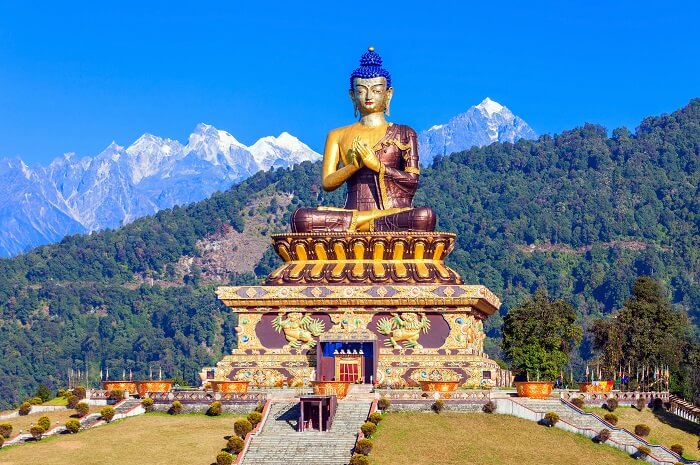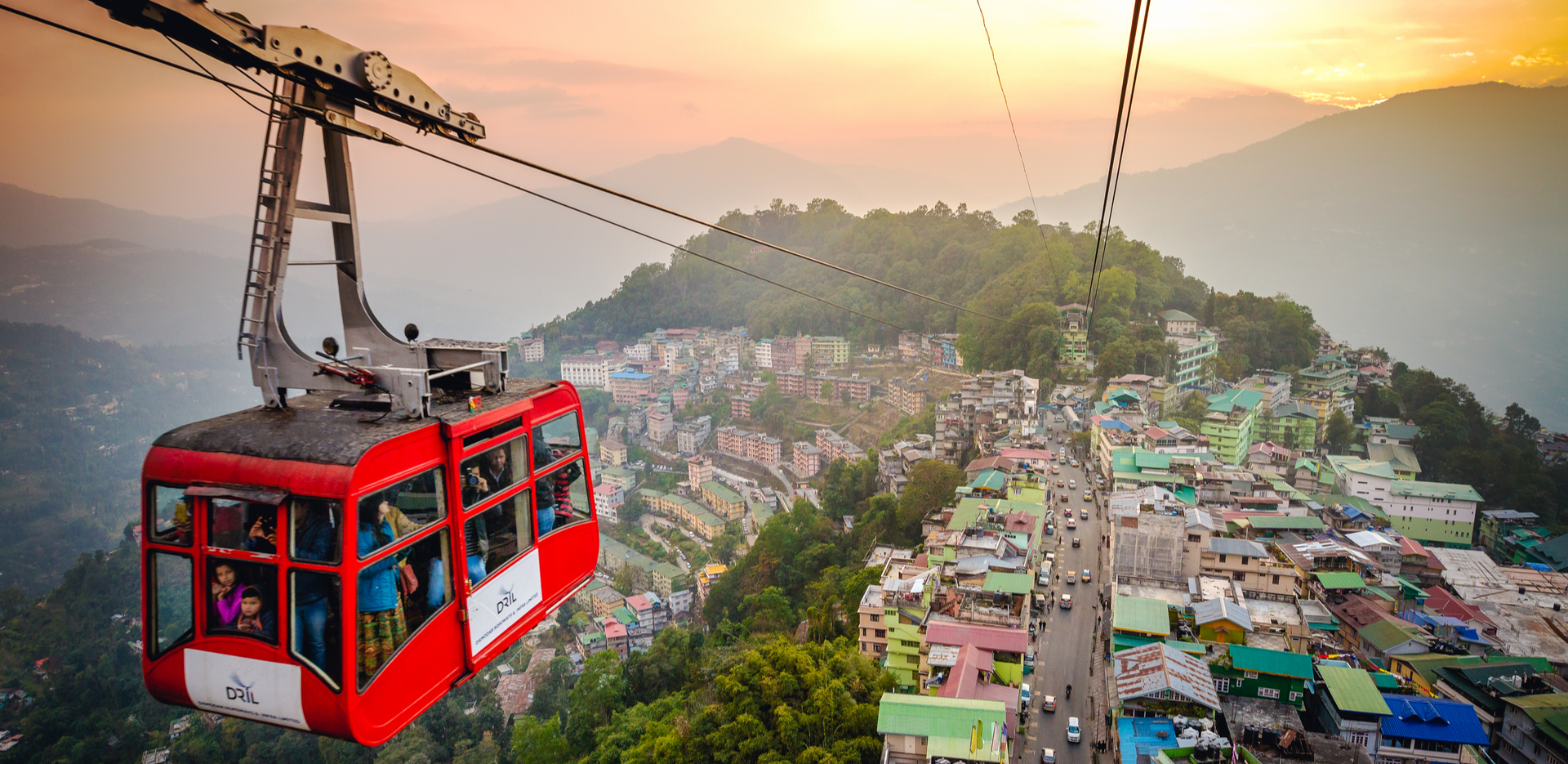Sikkim
Visit Sikkim
GANGTOK

Believe it or not, but resisting the alluring charm and appeal of Gangtok is almost impossible for anyone! The capital city of Sikkim, Gangtok is nestled in the Eastern Himalayas and is one of the kaleidoscopic tourist destinations in the state.
Whether you are looking for serene beauty, lush forests, gurgling rivers or mental peace, Gangtok travel packages will cuddle up your Sikkim holidays. For the nature lovers, a holiday in this scenic city is enough to fulfill all their wishes. On the other hand, for the adventure lovers, they can enjoy cable car rides, river rafting, go for mountain biking and several other activities in Gangtok.
Best Time to Visit: October to June
Tourist Attractions:
Rumtek Monastery
Nathula Pass
Tsomgo Lake
Seven Sister Waterfalls
Himalayan Zoological Park
Pelling

If you are an ardent fan of the captivating Himalayan Range, Pelling is the destination for you! It is from this Sikkimese town, one can have the best views of the Himalayas and the Kanchenjunga Peak, and can experience the best of their Sikkim holidays.
Located at a height of 7,200ft above the sea, this scenic town is bestowed with several waterfalls, breath-taking views, natural beauty and adventure options like rafting, kayaking, trekking, mountain biking and several others.
Best Time to Visit: Mid February to June
Tourist Attractions:
Kanchenjunga Falls
Singshore Bridge
Rabdentse Ruins
Khecheopalri Lake
Pemayangtse Gompa
Ravangla

Nestled amidst the Maenam and Tendong Hills, Ravangla is among the best places to visit in Sikkim; especially in the southern part of the state. A scenic town between Gangtok and Pelling, this hill-town also hosts some of the most popular treks in Sikkim.
More popular as a paradise for the bird watchers, it is home to some of the most rare and endangered birds in the world. On a usual visit to Ravangla, you can spot dark-throated thrush, verditre flycatchers, blue whistling thrush, babblers, cuckoos and several others.
Best Time to Visit:March, June
Tourist Attractions:
Buddha Park
Samdruptse Hill
Maenam Hill
Ralong Monastery
Doling Gompa
Namchi

Translated into the native Tibetan language, Namchi means the ‘top of the sky’. And on a visit to this magnificent Sikkimese city, this will be proved! Located around 92km from Gangtok and at a height of 1,675m above the sea level, it is also one of the most gorgeous cities in the state.
More than tourism, Namchi is more considered as a pilgrimage centre for the Buddhists. Amongst the important religious sites, the Namchi Monastery, Tendong Hill and Ralong Monasteries are the pre-dominant. The city also has a 108ft Lord Shiva statue and is visited a large number of Hindu devotees as well.
Best Time to Visit:March, June, October, and November
Tourist Attractions:
Char Dham
Siddheswar Dham
Tarey Bhir
Namchi Ropeway
Tendong Hill
Do-Drul Chorten

The largest Stupa in Sikkim, Do Drul Chorten was built in 1945 under the leadership of Truslshi Rimpoche. Holding a high prominence amongst all the religious sites in the state, this stupa is laced with 108 Mani Lhakor prayer wheels and is an ultimate place to connect with the essence of one’s inner-self.
Best Time to Visit: March to mid-June
OVERALL BEST TIME TO VISIT SIKKIM
Summer in Sikkim
Summer is considered to be the ideal time to explore this elegant state; Sikkim. During this season, the nature is at its best. This season is great for trekking too. You get a chance to see blooming field of orchids and
rhododendrons at the foot of the mountains and also by the side of winding ways going up to the hills. Almost all the visiting places; the lakes, the monasteries and the treks are in their inviting mood.
Monsoon in Sikkim
During monsoon, the state experience heavy rainfall throughout the months. While July be the wettest of all. Travelling by roads become obstructable and dangerous. The season is not much of an ideal time to visit the place but
becomes best for bird watching and to visit waterfalls. An analysis of rainfall in Sikkim shows that the annual rainfall is minimum at North-Sikkim and maximum at South-Sikkim. There is a low rainfall region i.e Namchi. Rainfall
in this area is about half of that in the other areas. So if plans pops up, one can surely visit North-Sikkim and avail the heavy discounts offered by the hotels to attract tourism.
Winter in Sikkim
The winter in Sikkim is extremely cold with never ending snowfalls. Winter temperature in the region averages between 4 °C (39 °F) and 7 °C (45 °F). But it looks mesmerising with snowcapped mountains, rivers and roads. Though
travelling might hinder if there is natural disaster, landslides, storm etc, especially in the northern region. Otherwise the place is quite welcoming and beautiful during these months.
Art And Culture of Kerala
Sikkim is the melting pot of various cultures. Like any other place, its culture is represented by its scrumptious cuisine, lively people, devout religion, jovial language, indigenous art & crafts, melodious music, and vibrant dance. Sikkim has emerged with its own distinct ethnicity even after being influenced by numerous cultures. Besides this, Sikkim boasts of a fusion of different communities, together with their religions. Scroll down to get more information about different facets of Sikkim culture.
Art and Craft Sikkim boasts of a rich culture of handicrafts too. Indeed the State Government is making constant efforts to promote the art & crafts of Sikkim. For this, the Handicraft and Handloom Institute has been established; it is solely dedicated to preserve and encourage the traditional cottage art and craft of authentic Sikkimese design. The wide array of handlooms and handicrafts comprise of carpets, wood carved furniture, thankas, and canvas wall hangings.
Food Of Sikkim
• Dal Bhaat
• Sael Roti
• Chhurpi Soup
• Sikkim Tea
• Dhindo
• Kinema Curry
• Momos